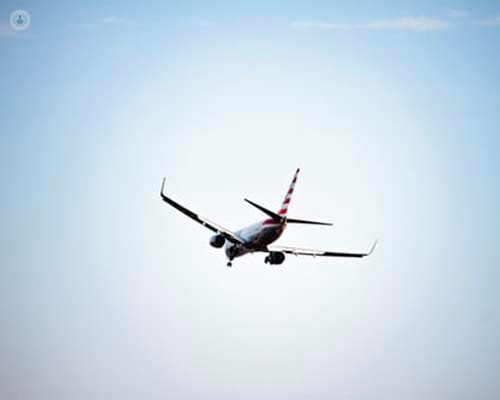Flying and ear pain: how to have a comfortable flight
Autore:Do you live with tinnitus or another ear condition and wonder whether taking a flight will make your ears worse? We’ve asked one of our leading ENT surgeons Professor Owen Judd whether it’s okay to fly with tinnitus, grommets or a perforated ear drum. He also shares his top tips on how to prevent or minimise ear pain, which may occur from a change in cabin air pressure to ensure that you have a comfortable flight.

Can cabin pressure and engine noise effect someone's tinnitus?
No not really. In fact, in most cases engine noise and the constant drone of the cabin ventilation can mask and alleviate tinnitus. Many tinnitus sufferers actually find flying a pleasure as it is one situation where their tinnitus can appear significantly reduced, or go away altogether!
However in some cases, if cabin pressure changes cause a pressure and muffling effect on the hearing, pre-existing tinnitus can briefly appear louder, but rapidly fades as the ears equalise via the Eustachian tube. This is a narrow tube that runs from the back of the nose to the middle ear space and is the space behind your eardrum.
In no way can changes in cabin pressure or engine noise actually cause or bring on a tinnitus that was not present before the flight.
Can you fly with grommets or a perforated eardrum?
Yes, in fact this actually means that you will not suffer any symptoms of pressure changes. A perforated eardrum means that any changes in pressure are instantly equalised directly through the hole and the Eustachian tube is essentially redundant. A grommet is a “ventilation tube” that is surgically inserted into the eardrum to maintain a hole, in conditions due to ETD. Therefore a grommet bypasses a poorly functioning Eustachian Tube and so constantly maintains pressure equalisation.
If you have a grommet, or have been told you have a perforated eardrum, you do not need to worry about and pressure symptoms or pain aboard a flight!
Read more: air travel & ear pain
How can I make sure I have a comfortable flight?
In the majority of cases the pressure changes on board an aeroplane and a matter of course and will not be a problem, as a normally functioning Eustachian tube will easily deal with any changes.
Any pressure or muffling symptoms can be easily remedied by chewing, swallowing or yawning along with reducing the chances of symptoms by keeping well hydrated and rested.
If you do start to develop discomfort or pain that is not relived by yawning or swallowing, a Valsalva manoeuvre can help.
If you have recently had a cold, have hayfever or nasal allergies, or have a history of ETD or previous problems on an aeroplane there are various things you can do:
- Suck a sweet or chew gum.
- Avoid getting dehydrated, as this thickens up any mucus which can exacerbate ETD – drink plenty of water during the flight and avoid alcohol.
- Avoid smoking before a flight as this thickens mucus and can make ETD worse.
- Use a simple saline nasal spray during the flight.
- Take an oral decongestant or use a decongestant nasal spray 30 minutes before take-off and landing to help reduce any inflammation of the Eustachian Tube. Read the medicines information leaflet to ensure you are safe to take these treatments, and avoid taking them for more than around four days in a row.
- Take anti-allergy medication if you have been prescribed them around 30 minutes before take-off and landing.
Read more from Professor Judd on how airplane ear effects the ears exactly.


